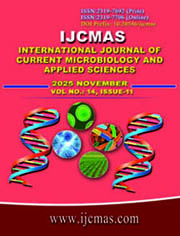Targeting Biofilm-Mediated Resistance: A Novel Insight into Fluconazole–Gentamicin Synergy in Vulvovaginal Candidiasis
Dakshina M. Nair*, Leela Kakithakara Vajravelu, R. Sujith Sri Surya, P. Deeksha and Alankritha Yadhunandhan
Department of Microbiology, SRM Medical College Hospital and Research Centre, SRM Institute of Science and Technology, Kattankulathur, Chengalpattu, Tamil Nadu, India
*Corresponding author
Abstract:
Vulvovaginal candidiasis (VVC) affects up to 75% of women worldwide, with recurrent episodes posing significant clinical and psychosocial challenges. While Candida albicans remains the predominant pathogen, Candida non-albicans species are increasingly reported and frequently exhibit antifungal resistance. Biofilm formation further complicates treatment, conferring enhanced tolerance to antifungal agents. This study investigated the species distribution, antifungal susceptibility, biofilm production, and the potential synergistic effect of fluconazole–gentamicin combination therapy against Candida isolates from VVC. A total of 120 vaginal Candida isolates from women aged 18–40 years were collected over eight months (June 2022–January 2023). Identification was performed using conventional mycological methods and CHROMagar. Antifungal susceptibility testing followed CLSI guidelines. Biofilm formation was assessed by microtiter plate assay, and minimum inhibitory concentrations (MICs) of fluconazole, gentamicin, and their combination were determined using broth microdilution. Candida albicans accounted for 35% of isolates, followed by C. parapsilosis (30%), C. glabrata (15%), C. krusei (11%), and C. tropicalis (9%). Fluconazole resistance was observed in 14.1% (17/120) of isolates, the majority of which 13 (76.4%) were strong biofilm producers. Combination therapy with fluconazole–gentamicin demonstrated a marked reduction in MIC values, with 84.6% (11/13) of resistant isolates showing restored susceptibility (MIC ≤ 2 μg/mL), compared to fluconazole or gentamicin monotherapy. Our findings suggest that fluconazole–gentamicin combination therapy exhibits promising synergistic activity against fluconazole-resistant Candida isolates, highlighting a potential alternative strategy for difficult-to-treat VVC cases.
Keywords: Vulvovaginal candidiasis, biofilm, fluconazole, gentamicin, minimum inhibitory combination
References:
- Lu M, Yu C, Cui X, Shi J, Yuan L, Sun S. Gentamicin synergises with azoles against drug-resistant Candida albicans. Int J Antimicrob Agents. 2018; 51(1): 107-114. https://doi.org/10.1016/j.ijantimicag.2017.09.012
- Bala M, Kumar RR, Magsi S, Fatima S, Nawaz N, Ashok U. Evaluation of Prevalence of Vaginal Candidiasis and Related Risk Factors: A Cross Sectional Study. Pakistan Journal of Medical and Health Sciences. 2022; 16(1): 604-607. https://doi.org/10.53350/pjmhs22161604
- Parvin R, Amin R, Mahbub MS, et al., Deep Fungal Infection-An Emerging Problem in Bangladesh. J Med. 2010; 11(2): 170-175. https://doi.org/10.3329/jom.v11i2.5466
- Villa S, Hamideh M, Weinstock A, et al., Transcriptional control of hyphal morphogenesis in Candida albicans. FEMS Yeast Res. 2020; 20(1). https://doi.org/10.1093/femsyr/foaa005
- Ghajari A, Lotfali E, Ahmadi NA, et al., Isolation of different species of candida in patients with vulvovaginal candidiasis from Damavand, Iran. Arch Clin Infect Dis. 2018; 13(6). https://doi.org/10.5812/archcid.59291
- Zeng X, Peng M, Liu G, et al., Strain Distribution and Drug Susceptibility of Invasive Fungal Infection in Clinical Patients With Systemic Internal Diseases. Front Bioeng Biotechnol. 2021; 8. https://doi.org/10.3389/fbioe.2020.625024
- Farhan MA, Moharram AM, Salah T, Shaaban OM. Types of yeasts that cause vulvovaginal candidiasis in chronic users of corticosteroids. Med Mycol. 2019; 57(6): 681-687. https://doi.org/10.1093/mmy/myy117
- Jasim ST. The Relationship between Vulvovaginal Candidiasis and Some Predisposing Factors in Prevalence among Baghdad Women. Systematic Reviews in Pharmacy. 2020; 11. https://doi.org/10.13140/RG.2.2.25087.43683
- Kalia N. Prevalence of Vulvovaginal Infections and Species Specific Distribution of Vulvovaginal Candidiasis in Married Women of North India.; 2015. https://www.researchgate.net/publication/291342505
- Qin F, Wang Q, Zhang C, et al., Efficacy of antifungal drugs in the treatment of vulvovaginal candidiasis: A Bayesian network meta-analysis. Infect Drug Resist. 2018; 11: 1893-1901. https://doi.org/10.2147/IDR.S175588
- Rodríguez-Cerdeira C, Martínez-Herrera E, Carnero-Gregorio M, et al., Pathogenesis and Clinical Relevance of Candida Biofilms in Vulvovaginal Candidiasis. Front Microbiol. 2020; 11. https://doi.org/10.3389/fmicb.2020.544480
- Purnamasari I, Ervianti E, Damayanti D, et al., Pattern of Candida Species Isolated from Patient with Vulvovaginal Candidiasis in Pregnancy. Berkala Ilmu Kesehatan Kulit dan Kelamin. 2022; 34(3): 178-183. https://doi.org/10.20473/bikk.v34.3.2022.178-183
- Polesello V, Segat L, Crovella S, Zupin L. Candida Infections and Human Defensins. Protein Pept Lett. 2017; 24(8). https://doi.org/10.2174/0929866524666170807125245
- Mohandas, Vinitha; Ballal, Mamatha. Distribution of Candida Species in Different Clinical Samples and Their Virulence: Biofilm Formation, Proteinase and Phospholipase Production. Journal of Global Infectious Diseases 3(1): p 4-8, Jan–Mar 2011. | https://doi.org/10.4103/0974-777X.77288
- Marak MB, Dhanashree B. Antifungal susceptibility and biofilm production of candida spp. Isolated from clinical samples. Int J Microbiol. 2018; 2018. https://doi.org/10.1155/2018/7495218
- Adhikary P. study of prevalence of candida albicans among the patients attending to outpatient services of gynaecology and obstetrics department with complaint of vaginal discharge. *Cor. https://doi.org/10.20959/wjpps20172-8667
- Selvan P, Vajravelu LK, Mohanraj H, Ramakrishna MS. Monitoring the Spectrum of Candidemia and its Anti-fungal Resistance in A Tertiary Care Centre – An emerging Global Alarm. J Pure Appl Microbiol. 2022; 16(4): 2704-2711. https://doi.org/10.22207/JPAM.16.4.41
- Lamsal S, Adhikari S, Raghubanshi BR, et al., Antifungal Susceptibility and Biofilm Formation of Candida albicans Isolated from Different Clinical Specimens. Tribhuvan University Journal of Microbiology. Published online December 31, 2021: 53-62. https://doi.org/10.3126/tujm.v8i1.41195
- Sherry L, Kean RMcKloud E, O'Donnell LE, Metcalfe R, Jones BL, Ramage G.2017.Biofilms Formed by Isolates from Recurrent Vulvovaginal Candidiasis Patients Are Heterogeneous and Insensitive to Fluconazole. Antimicrob Agents Chemother61: 10.1128/aac.01065-17. https://doi.org/10.1128/aac.01065-17.
- Tits J, Cammue BPA, Thevissen K. Combination Therapy to Treat Fungal Biofilm-Based Infections. Int J Mol Sci. 2020 Nov 23; 21(22): 8873. https://doi.org/10.3390/ijms21228873. PMID: 33238622; PMCID: PMC7700406.
- Jeniel E. Nett, Hiram Sanchez, Michael T. Cain, David R. Andes, Genetic Basis of Candida Biofilm Resistance Due to Drug-Sequestering Matrix Glucan, The Journal of Infectious Diseases, Volume 202, Issue 1, 1 July 2010, Pages 171–175, https://doi.org/10.1086/651200
Download this article as 
How to cite this article:
Dakshina M. Nair, Leela Kakithakara Vajravelu, R. Sujith Sri Surya, P. Deeksha and Alankritha Yadhunandhan. 2025. Targeting Biofilm-Mediated Resistance: A Novel Insight into Fluconazole–Gentamicin Synergy in Vulvovaginal Candidiasis.
Int.J.Curr.Microbiol.App.Sci. 14(11): 66-74. doi:
https://doi.org/10.20546/ijcmas.2025.1411.007
 Citations
Citations



 National Academy of Agricultural Sciences (NAAS)
National Academy of Agricultural Sciences (NAAS) 




